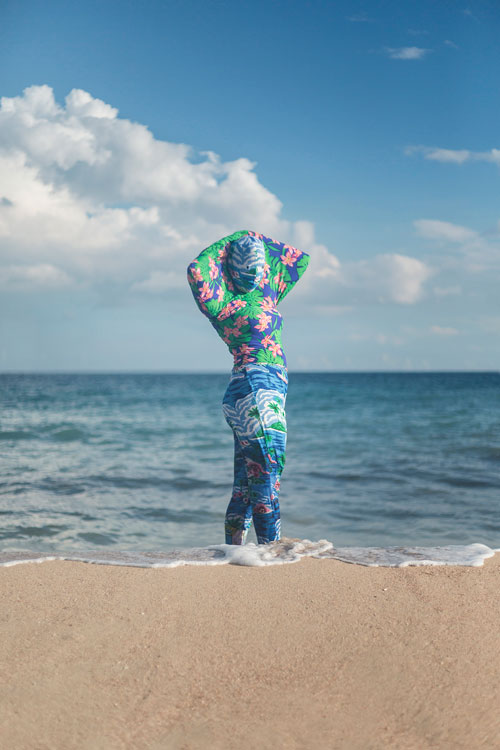PROVIDENCE, R.I. [Brown University] — The David Winton Bell Gallery at Brown University kicks off the 2019-20 school year with “Fertile Ground,” an exhibition of works by three artists whose work portrays female bodies in nature. The exhibition opens on Saturday, Aug. 31 and runs through Sunday, Nov. 3, with an opening reception and artist talk on Friday, Sept. 13 at 5:30 p.m.
Exhibit curator Heather Bhandari, who has been an adjunct instructor of visual art at Brown for eight years, said she believes the three artists’ work will resonate not only with the general public but also with students at Brown. Each of the artists — María Berrío, Zoë Charlton and Joiri Minaya — explore topics such as land ownership, immigration and tourism as they relate to women of color.
“I was trying to conceive of a show at Brown that related to some of the topics I’ve seen students dealing with in their work,” Bhandari said. “Their art brings up issues of identity and race, where they’re from and evolving understandings of their bodies in relationship to their current environment.”
Bhandari had long admired work by each of the three artists. When she realized how much their art had in common, she wanted to merge their work into one exhibition for the first time.

“The three of them come from different backgrounds, but they are involved in a similar dialogue,” she said. “All of them are dealing with women’s bodies and identities in some way.”
Berrío, a native of Bogotá, Colombia, came to the United States for college. Her work explores the tension she feels between nostalgia for her homeland and optimism that a life in the U.S. could yield new opportunities — something immigrants have explored in art, literature and performance for centuries. Using hundreds of pieces of paper collected from destinations across the globe, Berrío creates collages of strong, powerful women in transit between their old and new homes, sometimes with children in tow.
“In María’s work, the land is a woman’s partner,” Bhandari said. “Women are one with the land as they travel on foot or on boats to find a new life.”
By contrast, the work of Charlton, who grew up in Florida, paints a more fraught picture of women’s relationships to land. Charlton’s grandmother, Everlena Bates, was one of the first African American women to own land in Florida. Her family’s recent decision to sell the lot, to which Charlton felt a close connection, brought up complicated feelings for the artist. Charlton’s huge, swirling collages use stickers, paper and gouache paint to depict women who are enveloped by their natural surroundings, almost as if the land is defining their identities.
According to Bhandari, Charlton’s pieces are each titled with phrases from Frederick Douglass’ famous speech “What to the Slave is the Fourth of July?” Douglass’ 1852 speech exposed racial inequalities in treatment and opportunity in the newly formed United States; many still cite the speech and find it relevant today.
“Owning land an a home is a classic American dream, but it’s not a possibility for most of this country, and certainly not for most African Americans,” Bhandari said. “Zoë’s work helped me recognize how extraordinarily different my relationship to land is [as a white woman].”
Minaya’s work criticizes the ways in which tourism has defined the perception of women in the Dominican Republic, where she grew up. In many parts of the Caribbean, said Bhandari, cruise ships will dock on stretches of land that are fenced off to local residents. These tourist beach areas are often surrounded by walls so that tourists and locals can’t even make eye contact — unless locals happen to work at beach bars and restaurants, where they are often encouraged to inhabit a certain persona.
“Joiri searched social media and Google to see how women in the D.R. portrayed themselves,” Bhandari said. “A lot of times, they’re in front of the beach, wearing tropical prints and positioned in one of only a few poses.”
Minaya’s artwork features portraits of Dominican women, including herself, wearing tight spandex outfits that force them into tourist-friendly poses, always backed by idyllic tropical settings. In an accompanying video, Minaya illustrates the contrast between Labadee, Haiti's sanitized, walled-off tourist areas, and its local neighborhoods.
Bhandari said she hopes the exhibition helps visitors think about their own relationships to land.
“I want people to think about where they come from and how their homelands have helped shape their view of the world,” Bhandari said. “I think this exhibition is a good starting point for a larger discussion on race, wealth and identity.”
The exhibition “Fertile Ground” runs in the Bell Gallery through Sunday, Nov. 3. An opening reception on Friday, Sept. 13 at 5:30 p.m., features a conversation with the artists moderated by Bhandari. The Bell Gallery is open Mondays, Tuesdays, Wednesdays and Fridays from 11 a.m. to 4 p.m., Thursdays from 1 p.m. to 9 p.m., and weekends from 1 p.m. to 4 p.m.